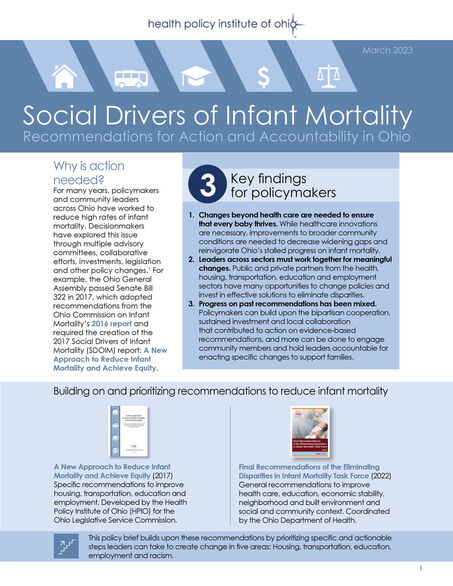Social Drivers of Infant Mortality:
Recommendations for Action and Accountability in Ohio
Why is action needed?
For many years, policymakers and community leaders across Ohio have worked to reduce high rates of infant mortality. Decisionmakers have explored this issue through multiple advisory committees, collaborative efforts, investments, legislation and other policy changes. For example, the Ohio General Assembly passed Senate Bill 322 in 2017, which adopted recommendations from the Ohio Commission on Infant Mortality’s 2016 report and required the creation of the 2017 Social Drivers of Infant Mortality (SDOIM) report: A New Approach to Reduce Infant Mortality and Achieve Equity, which was completed by HPIO.
Infant mortality prevention efforts have largely focused on public health and healthcare interventions for pregnant women, such as safe sleep education and prenatal care access. While these efforts have likely contributed to the overall reduction in infant mortality, healthcare services alone are not enough to close gaps in birth outcomes in Ohio. Improvements in factors beyond access to care are needed to reinvigorate Ohio’s stalled progress on infant mortality reduction.
This brief, produced as a five-year follow-up to HPIO’s original SDOIM report, provides guidance to policymakers and other stakeholders on how to improve community conditions and achieve birth equity through:
- Twelve prioritized policy goals and a menu of specific recommendations
- Steps for acting on the policy recommendations
- An update on implementation progress on the 2017 SDOIM report recommendations, including opportunities to continue progress and overcome barriers in 2023 and beyond
3 key findings for policymakers
- Changes beyond health care are needed to ensure that every baby thrives. While healthcare innovations are necessary, improvements to broader community conditions are needed to decrease widening gaps and reinvigorate Ohio’s stalled progress on infant mortality.
- Leaders across sectors must work together for meaningful changes. Public and private partners from the health, housing, transportation, education and employment sectors have many opportunities to change policies and invest in effective solutions to eliminate disparities.
- Progress on past recommendations has been mixed. Policymakers can build upon the bipartisan cooperation, sustained investment and local collaboration that contributed to action on evidence-based recommendations, and more can be done to engage community members and hold leaders accountable for enacting specific changes to support families.
Prioritized recommendations
Released in 2017, A New Approach to Reduce Infant Mortality and Achieve Equity (“the 2017 SDOIM report”) identified 127 policy recommendations in housing, transportation, education and employment to reduce infant mortality in Ohio. Of those original policy recommendations, the majority saw some progress towards implementation, but very few were fully implemented. Visit the implementation progress and barriers section on page 15 for more information.
To inspire more focused action on the most important factors that contribute to infant mortality, HPIO’s Social Drivers of Infant Mortality Advisory Group distilled and prioritized that list down to 12 policy goals and 44 key recommendations. This includes 3 new policy goals focused on eliminating racism to decrease disparities in infant mortality.
By:
Hailey Akah, JD, MA
Amy Bush Stevens, MSW, MPH
Published On
March 17, 2023
 Download Publication
Download Publication
